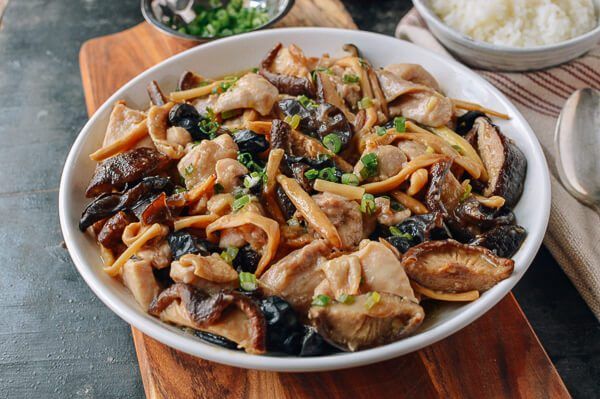As a part of American culture and upbringing, holidays from the United States are deeply ingrained in almost all Americans. It was a difficult adjustment for my parents, who were immigrants from Taiwan. They were especially receptive to holidays that revolved around food. My mom would always make a home-cooked meal, but it was usually a mix of American and Chinese dishes or Chinese-adapted dishes. She used whatever ingredients were available at the local grocery store.
My parents immigrated to the United States in 1960s from Taiwan. My mom managed to escape her small, conservative Asian town by graduating high school and attending the top university in Taiwan. She then went on to attend grad school in New York State. My father met her here. Both of them had to make a major change. They moved from a small island in the tropical South to the East Coast of the United States. My father was a career academic and they moved around to several college towns before landing in St. Louis, Missouri. This is a mid-sized metropolitan area located at the intersection between the Midwest, South.
Our Thanksgiving table consisted of the same food that every Midwest family had back in 1980s. The traditional Thanksgiving turkey was served, usually from a local grocery store. My parents fed three hungry children on a college professor’s salary. However, there were times when we indulged in a Butterball. My mom would mix the potato flakes in the boiling water and cook the mashed potatoes until it was thick enough for us to eat. I learned how to make mashed potatoes with real potatoes in college. Stove Top stuffing is a Midwest classic that makes me feel nostalgic. Jellied Cranberry Sauce was a must-have for Thanksgiving. We used the canned sauce and sliced it in a dish to see the ridges. My mom was the only one who ate the dish.
My white friends wouldn’t know that there were Chinese dishes scattered throughout the table. White Corningware casseroles always contained sticky glutinous rice, which had been stir-fried along with strips of carrots or bamboo shoots. The meal began with a large bowl of corn and eggdrop soup. Then came the napa cabbage and dried shrimp, which sparkled in the evening sunlight.
St. Louis wasn’t the place to find many Asian produce at the time. To find Asian grocery stores and Chinese food, you had to travel to a specific area of town. Even then, the selection was not the best. My mom, a naturalized person, bought the closest thing they could find to what was available in her native country. It was always a matter of finding, replacing, and adapting. They made it work. Hamilton sang, “Immigrants. They do the job.
Napa cabbage was not something that needed to be replaced often. Even in 1980s supermarket chains, it was easy to find. It could be easily substituted with regular green cabbage if it wasn’t available to my mom. Growing up, she kept a huge amount of it in her fridge.
Even though I don’t make napa with shrimp very often, I find that it brings back memories of my childhood. When I dry the shrimp, the salty smell of the ocean wafts up in my nostrils and makes me think about my mom. It makes me wonder if it reminds my mom of her childhood on a tropical island halfway across the globe. The act of cutting a huge head of napa cabbage reminds me how I used to think my mom was a wizard at the stove. She managed to fit all the vegetables into the wok and marveled at how the size shrinks. Her method of thickening the sauce for cabbage was to make the cornstarch-slurry in cold water. Finally, she added salt to the dish with a tiny ceramic spoon that she purchased on a European trip. My mom always whispers to me when I salt my food. She says that a little salt will go a long way but that if it tastes dry, add more.
Although stir-fried napa cabbage is not the first thing people think of when they think about American Thanksgiving, it’s an important addition. My Thanksgiving is now a combination of a brined turkey, homemade stuffing, creamy mashed potatoes, and homemade stuffing. But my mom still inspires me to add more vegetables to the table. Each year, I experiment with new vegetables, such as slow-braised rosemary carrots or roasted Brussels sprouts. The napa cabbage is one thing that you will always find.
What is Napa Cabbage?
Napa cabbage, also known as Chinese cabbage, has mild flavor and is often used to make Asian dumpling fillings. This cabbage is large and oblong, sometimes as big as a football. It is not a large cabbage, but it can be steamed and shrinks significantly.
What is dried shrimp?
Dried shrimp is just what it sounds like. It’s small shrimp that have been dried. This Chinese dish has a salty umami kick thanks to dried shrimp. Asian grocery stores sell dried shrimp in frozen and refrigerated sections. You should look for small-sized dried shrimp that are about 1/4 inch in size. For medium- or large-sized dried shrimp, you will need to hydrate them with more water (1 cup for medium-sized shrimps, 1 1/4 cups for large shrimps) for 45 to 60 minutes. After that, coarsely chop the shrimp into 1/4-inch pieces.
Do I have the ability to make this dish ahead?
This dish tastes best when it’s fresh from the oven. However, leftovers can be stored in an airtight container in the refrigerator for up to 2 days. Then, reheat the dish on the stovetop or in the microwave.
Irvin Lin’s Napa Cabbage and Dried Shrimp
PREP TIME: 10 minutes
MISCELLANEOUS TIME: 30 minutes
TOTAL TIME: 40 minutes
SERVINGS: 4-6 servings
This Chinese dish is enhanced with dried shrimp. It can be found in Asian grocery stores in the refrigerated or frozen section. You will want small-sized dried shrimp that are about 1/4 inch in size. For medium- or large-sized dried shrimp, heat the shrimp in more water (1 cup for medium-sized shrimp; 1 1/4 cups for large); then, after it has hydrated for 45 to 60 minutes, cut into 1/4-inch pieces. You can make this vegetarian by omitting the dried shrimp. Instead, use four to five dried shiitake mushrooms.
Ingredients
- 2 tablespoons of dried shrimp, small preferred size, 1/4 inch in size
- 1 to 3 cups boiling water is enough to cover the shrimp generously
- 1 medium head (2 pounds) napa cabbage
- 2 tablespoons peanut oil or vegetable oil
- 4 scallions, cut in 1-inch pieces
- 1 tablespoon, or about a 1-inch-long piece of fresh ginger
- 1 tablespoon soy sauce
- 1 tablespoon of cold water
- 2 teaspoons cornstarch
- 1 teaspoon kosher Salt, plus additional to your taste
- 1/2 teaspoon of white pepper plus additional to taste
Method
- Rehydrate dried shrimp
The dried shrimp should be placed in a small bowl. Pour the boiling water over the shrimp. Cover the shrimp with a plate and allow it to rest for 30 minutes. The shrimp will appear lighter and slightly plump.
- Make sure to wash the cabbage before you start cooking it.
Split the napa cabbage in half. Rinse the cabbage, and dry it. Remove the core from the cabbage and throw it away.
Two large bowls are needed. Divide the remaining cabbage into 1-inch chunks. Place the thicker white pieces towards the bottom of the cabbage in one bowl, and the thinner leafy green pieces toward the top in the other.
- Drain the shrimp
Drain the shrimp once it has rehydrated and then discard the liquid.
- Make sure to cook the shrimp and cabbage.
Place the peanut oil in a large skillet or wok on high heat. Stir it around to coat the pan.
Once the oil is shimmering hot, heat the mixture and then add the scallions. Use a spatula to mix the ingredients until they are fragrant and the scallions turn a bright green color. This should take about one minute.
Reduce the heat to medium-high and add the napa cabbage’s thicker white portion to the pan. Cook and stir for about 3-4 minutes or until the cabbage pieces begin to turn translucent, but the center remains opaque.
Turn down the heat and add the chopped leafy green cabbage pieces to the pan. Cook the leaves for 2 minutes.
- Make a cornstarch-slurry:
Combine the soy sauce, cornstarch, and cold water in a small bowl. Stir to create a slurry. Stir in the remaining ingredients and cook the cabbage until the sauce thickens slightly to the consistency that whole milk.
- Season the stir-fry:
Season the stir-fry with salt and pepper. If necessary, taste it and adjust salt and pepper as needed. The cabbage should be translucent and silky, with dried shrimp specks all over.



